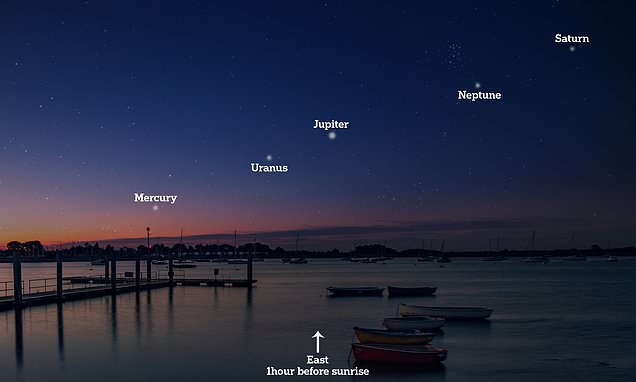
Look up this weekend! FIVE planets will be visible in the sky on Saturday morning – how to see Jupiter, Saturn, Mercury, Neptune and Uranus
- A rare planetary parade will be visible on June 17 an hour before sunrise
- Alignments take place when a number of planets are in the same constellation
Stargazers are in for a treat this weekend as five planets are set to align in a rare planetary parade.
Mercury, Uranus, Jupiter, Neptune and Saturn should be visible one hour before sunrise on June 17 as they line up near the eastern horizon.
Three of the brighter planets – Jupiter, Mercury, and Saturn – can be viewed with the naked eye, providing you’re in a good spot.
But Brits will need binoculars or a telescope to catch sight of Neptune and Uranus, with the latter being 7° lower than Jupiter, according to Starwalk.
Planetary parades, or alignments, take place when a number of planets are located in the same constellation.
Mercury, Uranus, Jupiter, Neptune and Saturn should be visible one hour before sunrise on June 17 as they line up near the eastern horizon
TIPS TO SEE THE ALIGNMENT
- Get as far away as possible from city lights to a place with dark skies
- Be set up and ready before the sun sets
- Check ahead to make sure the weather is fine and cloudless
- Find a clear spot with an unobstructed view of the horizon
- If possible, have a pair of binoculars or even a telescope handy for a clearer view
This alignment of planets is fairly uncommon, with the next event set to take place in April 2024.
It will occur in a 93-degree sector, meaning the planets will appear closer together in a small area of the sky.
Saturday morning is the best time to view each of the planets, but Saturn will actually rise in the dead of night on June 16 in the constellation of Aquarius.
During the parade, Jupiter will be in the constellation of Aries, while Mercury will be in the constellation of Taurus.
June 17 is also the best day to spot these in the US, according to MRT, ahead of its new Moon 12:37 am (ET) the next day.
But, in order to catch a glimpse, it’s important to find a good stargazing spot.
NASA recommends checking the weather forecast ahead of time to find a cloudless area.
This should also provide an unobstructed view of the horizon, avoiding buildings and any blaring city lights.
Bringing binoculars or even a telescope is handy too, especially for spotting the less obvious planets like Neptune and Uranus.
To differentiate between stars and planets, watchers should look for objects that don’t twinkle amid the flickering stars.
If you do miss out on the spectacle – don’t worry.
Brits will need binoculars or a telescope to catch sight of Neptune and Uranus, with the latter being 7° lower than Jupiter (stock image)
There are numerous other spectacles taking place in the night sky this month.
The northern hemisphere will experience the longest day of the year on June 21 which is known as the summer solstice.
Brits will have much longer days and shorter nights as a result, allowing us to spend more time in the summer sun.
At 8.40pm GMT tomorrow, the Moon will also appear near Mercury in the constellation of Taurus.
To easily identify the planets this month, the educational astronomy application Star Walk recommends using the app Sky Tonight, which can be pointed at the night sky to give a live display of what is going on.
DOES PLANETARY ALIGNMENT HAVE AN EFFECT ON EARTH?
The planets in our solar system never line up in one perfectly straight line like they show in the movies.
If you look at a two-dimensional plot of the planets and their orbits on a piece of paper you may be lead to believe that all the planets will circle around to the same line eventually.
In reality, the planets do not all orbit perfectly in the same plane. Instead, they swing about on different orbits in three dimensional space. For this reason, they will never be perfectly aligned.
Planetary alignment depends on your viewpoint. If three planets are in the same region of sky from Earth’s point of view, they are not necessarily in the same region of sky form the sun’s point of view.
Alignment is therefore an artifact of a viewpoint and not something fundamental about the planets themselves.
Even if the planets did all align in a perfectly straight line, it would have negligible effects on Earth.
Fictional and pseudo-science authors like to claim that a planetary alignment would mean that all of the gravitational fields of the planets add together to make something massive that interferes with life on Earth.
In truth, the gravitational pulls of the planets on the Earthare so weak that they have no significant effect on Earth life.
There are only two solar system objects with enough gravity to significantly affect Earth: the moon and the sun.
The sun’s gravity is strong because the sun is so massive. The moon’s gravitational effect on the Earth is strong because the moon is so close.
The sun’s gravity causes Earth’s yearly orbit and therefore, combined with earth’s tilt, it causes the seasons.
The moon’s gravity is primarily responsible for the daily ocean tides. The near alignment of the sun and the moon does have an effect on the Earth, because their gravitational fields are so strong.
This partial alignment occurs every full moon and new moon, and it leads to extra strong tides called ‘spring tides’.
The word ‘spring’ here refers to the fact that the water seems to leap up the shore with the extra strong tides every two weeks – not that they occur only in the spring season.
Source: Dr Christopher S. Baird/West Texas A&M University
Source: Read Full Article

